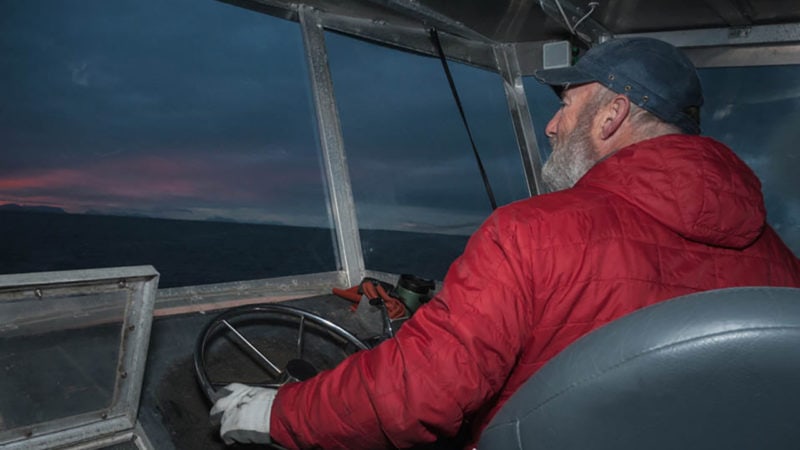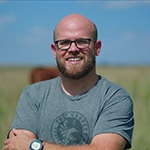Last Updated on January 30, 2025
Matt Luck is the founder of Pride of Bristol Bay and Alaska Wild Caught Seafood, ventures that source wild-caught salmon from small, family-run fishing operations in Bristol Bay, Alaska. As a fisherman and purveyor, Matt supplies the sustainably-harvested wild Alaskan salmon now available through ButcherBox through his company Alaska Wild Caught Seafood.
For more than 40 years, Matt has been fishing Bristol Bay, which is about 450 miles southwest of Anchorage, along with 1,500 independent family-run boats fish Bristol Bay. Corporations are not allowed to fish in the region.
The Bristol Bay region connects to five major river systems where — each year — sockeye salmon return to spawn. Each river system is monitored so that it produces a sustainable amount of fish. The fishing boats are only allowed to harvest fish once the Alaska Department of Fish and Game has determined that the total run is on track to meet escapement goals.
This past year was quite successful for Matt and his fellow Bristol Bay fisherman, as the bay saw the largest number of salmon return — 62 million — since records were first kept in 1893.
We are excited to be working with fisherman like Matt Luck to bring our members wild-caught Alaskan sockeye salmon. Recently, we chatted with Matt who, although he spent a lifetime fishing in Alaska and now calls Ketchum, Idaho home, grew up a stone’s throw from the ButcherBox offices in Boston.
ButcherBox: Matt, great to chat with you, can you tell us how you ended up fishing in Bristol Bay, Alaska?
Matt Luck: Well, I was raised just off Beacon Street in Newton, Massachusetts, not far from your offices. One of my dad’s close personal friends was Mel Stavis. Stavis Seafoods is one of the largest seafood distributors in New England, and Mel was the patriarch who started the company, which was based in Boston.
One day, Mel gave me his card and told me that if I ever want to go to Alaska, he would find me a job in a cannery. Well, when I was 18, I pulled out the card, called him up, and I went up to Alaska to work in the summers to pay for college. I worked in the cannery for about a week, was offered a job on a fishing boat and that is how it all started. Three years later, I decided that there was nothing I would rather do than make a life for myself commercial fishing. That was about 1978, and I’ve been there since.
ButcherBox: And you just fell in love with Alaska, fishing, or both?
ML: Well, I lived in a little town called Cordova, and I ended up meeting my wife there, and we were married in 1983.
It was a different time for the fishing industry, there were a lot of young people there at the time. There were a lot of opportunities, especially if you worked hard. I did well and just stayed and we raised our family.
Over the years we’ve had multiple boats, participating in fisheries from southeast Alaska to the Bering Sea. But now I just have the one boat in Bristol Bay and fish the two months of the year.
BB: And how did Pride of Bristol Bay and Alaska Wild Caught Seafood come about?
ML: I have been involved in trade associations and served on a number of boards and commissions, including doing things like recommending escapement goals to the river systems in Bristol Bay and other industry work groups.
About six years ago, I decided to start a direct marketing business that delivered salmon directly to consumers, similar to what ButcherBox is doing. My harvesting operation is completely separate, and would just source the product back to companies I’ve fished for or that I’ve had relationships with for over three decades.
That’s pretty much it in a nutshell.
BB: Can you talk more about fishing for sockeye?
ML: All of the products that ButcherBox distributes is caught inside of Bristol Bay, which is north of the Alaskan peninsula. This past summer, 62 million sockeye salmon returned to the five rivers system of the Bristol Bay region to spawn. Consider that the average number of fish that have returned over the past 30 years has been about 27 million salmon.
In Bristol Bay, all fish are harvested in one of two ways, either drift gillnetting — boats with large nets that move through the channels and flats with the tide — or set netters who fish from shore. I’m a drift gillnetter.
The way all salmon fisheries are regulated in Alaska is under a program called limited entry which I believe was started in 1973. In each individual region, there is a requirement that somebody on the boat owns a permit. Permits can only be owned by individuals. They can’t be owned by corporations.
Basically, there are 1,500 boats owned by individuals permitted to fish in Bristol Bay, and I am one of them.
There is also a limit on the length of the boat, which can only be 32 feet long.
All of the regulations have developed over the years with sustainability in mind, and to create a landscape where it’s a competitive fishery. This management has been kind of the poster child for sustainable fisheries, globally.
BB: What do you mean when you refer to escapement goals and sockeye salmon?
ML: Every year there are escapement goals set every year based on the year prior. This is a requirement that a certain number of fish get up into each river system to spawn, so that there are enough fish in the spawning habitat, so that there are enough eggs, for enough fry hatch in the spring, and enough smolts go out to the ocean when it’s time for them to migrate.
When they return, each river system produces a sustainable amount of fish. We’re only allowed to harvest the surplus. It’s a fairly short window in the summer when the fish return — about a six-week period — during which a member of the staff of the Alaska Department of Fish and Game, usually a management biologist, manages each river system. That river manager has an escapement goal that is monitored daily to make sure the forecasted run is on track.
Until enough fish go by the counters the commercial fishery stays closed. This guarantees that, barring some environmental disaster, they’re going to get an adequate number of spawners into the spawning ground.
This past summer, one of the rivers had an escapement goal of 2.1 million fish and, actually, eight million fish got to the spawning grounds because we couldn’t stop them — even fishing 24 hours a day.
BB: How often do you eat fish after years in harvesting fish?
ML: My wife and I probably eat seafood three or four times a week, and it’s the same salmon that ButcherBox is distributing.
We love smoked salmon as well. I will smoke 40 or 50 pounds of sockeye a year and pickle it as well.
One thing we’ve been eating a lot lately is poke. Usually, poke is made with yellowfin tuna, but I like to take cubes of raw sockeye that you put in a bowl with coarse sea salt, sesame oil, green onion, cucumber, and red pepper flakes, and roll it all together.
You can also skin a fillet, season with your favorite herbs and spices, sear it on each side for a couple of seconds and then slice it, and it is like eating like sashimi.
But our favorite is a bake and grilled recipe. You rub a fillet with olive oil and salt and pepper, bake at 350 degrees for six or seven minutes, or grill, skin down, for six to seven minutes.
BB: How long are you going to keep fishing in Alaska?
ML: I’m probably going to continue to fish in Bristol Bay until I can’t climb the ladder to the bridge anymore. It helps me keep connected with the network of friends that I’ve had over the years and connection with the industry, and really that’s why I really enjoy having built this direct to consumer business.
I think it’s really important for people to have the opportunity to understand where their protein is being produced, who the producers are, who the harvesters are, and create that connection between those who fish and the consumer.
Being part of that whole model where people know where their food comes from helps me stay connected with something that has been my whole life for 40 years. You know, my kids grew up on the boat and they’ll still come back to work on the boat.
Fishing has been part of my life and I want it to remain part of my life right to the very end.
Dennis Keohane is a writer, editor, and former Editorial Director for ButcherBox with a passion for storytelling and food. Combining his love for high-quality ingredients with engaging narratives, he crafts content that inspires home cooks to explore new flavors, techniques, and the joy of cooking.



